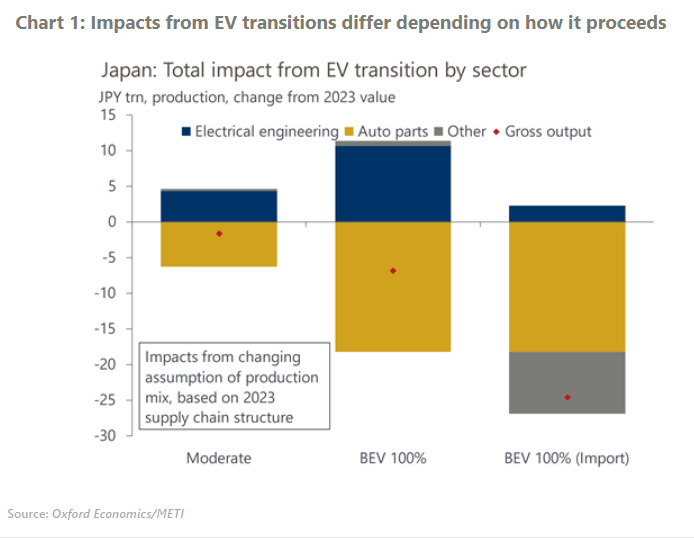EV shift could pose a big challenge to Japanese economy
Amid the fast-progressing electric vehicle (EV) shift, maintaining high competitiveness in auto-related sectors and ensuring a smooth labour transition across industries are crucial for the growth of the Japanese economy. As auto production shifts towards EVs, which require different inputs from traditional internal combustion engine cars, parts suppliers will need to adapt to avoid losing market share to foreign players. Change in automotive supply chains would also require workers to move across different industries, a task particularly challenging for Japan.
What you will learn:
- The Japanese economy is reliant on the auto industry, as the sector accounts for 15% of industrial production. Furthermore, the sector has one of the highest multiplier effects, given breadth and depth of its supply chains. Spillover effects are seen not just in auto parts, but also among commerce, plastics, electronics, and metal industries.
- The EV transition would bring about a huge change to the current supply chain structure. While demand for parts like electric motors and lithium-ion batteries will increase, there would be less demand for engines and transmissions. Our analysis reveals that the economy will be hit as EV transition proceeds, but the magnitude will depend on the nature of the transition.
- There would be a limited impact if hybrid vehicles retain as high a share of production as the Japanese government currently expects. However, if the entire auto production shifts to battery EVs, Japanese gross nominal output would be 0.6% lower than the 2023 level.
- Because the EV transition will reshape the industry structure, a smooth reallocation of labour across industries is imperative for the transition to work. Otherwise, capacity of EV goods providers will be strained, potentially raising the import dependency of the sector. We simulated a scenario where a considerable part of the input for battery EVs is sourced from abroad, in which case 2.2% of Japan’s gross nominal output and 1.1% of total employment will be lost.

Tags:
Related Posts

Post
Japan’s worsening fiscal outlook raises risk of higher term premium
We expect Japan's fiscal outlook to deteriorate due to weak economic growth and pressure on the government to implement fiscal stimulus. We don't think deficit concerns drove the recent spike in ultra-long Japanese government bond (JGB) yields, but as domestic purchasers reduce their JGB holdings, long-term yields could become more sensitive to fiscal developments in the coming quarters, raising the risk of a higher term premium.
Find Out More
Post
Identifying future manufacturing hot spots in Japan
Japan's industries, which are exposed more to international demand than to tepid domestic demand, are often concentrated in certain cities. This makes these cities more dynamic than others, a feature masked when only looking at national data. Understanding the industrial landscape helps identify growth opportunities across various sectors, as job creation and incomes drive spending.
Find Out More
Post
Tariff turbulence will diminish the BoJ’s chance of rate hike
The Bank of Japan kept its policy rate at 0.5% at Thursday's meeting. Considering the significant downgrading of growth and inflation forecasts in its Quarterly Outlook Report, the central bank will likely take a long pause to assess the impact of high global trade policy uncertainty on growth and inflation.
Find Out More